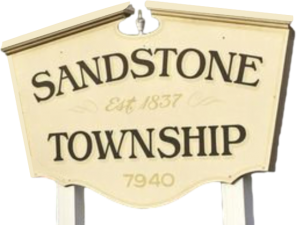About Us
Fun Facts
Sandstone Township is 36 square miles, so it is 6 miles long and 6 miles wide. The east boundry is Blackman Rd., the west boundry is N. Parma Rd., the north and south boundries do not fall on roads. The south boundry is south of Michigan Ave. approximately 1/4 mile, and the north boundry is north of Pomeroy Rd. approximately 1/4 mile and north of Maines Rd. approximately 1/2 mile. Google maps link.
The population of Sandstone Township is 3984 according to the 2010 census.
All county roads in Sandstone Township are paved except for a 1/4 mile road near the Water tower.
View the official Township zoning map with this link
History of Sandstone Township
The following information was found in the Township files. The author, and the date it was written is unknown. The accuracy has not been verified, but it is interesting reading about the history of our Township.
Supervisor, Dwight VanWinkle
Settlement of Sandstone Township preceded that of Parma Township by several years, the former dating back to 1830. It was near the current intersection of Sandstone and Michigan Ave that the Village of Barry sprang up rivaling Jackson in importance for some time. There are still legal platted descriptions of lots based on a plan for the Village of Barry. At one time, Barry was being considered as a possible site for the capital of the new State of Michigan.
In the Township was Sandstone Creek, which received its name because of a large deposit of sandstone rock along its bed. Near this creek, at a point six miles west of Jackson, the original settler of Sandstone Township, Samuel Roberts, broke ground for a farm in May 1830. Most of the thickly timbered land was of a heavy loam soil, yielding good crops.
Two years after Mr. Roberts settled in Sandstone Township, the Village of Barry was platted. Barry was destined to flourish for a brief span of years and become one of the most thriving communities of this section of southern Michigan.
An interesting view of Barry can be seen in an account written by one of the Village’s early residents, Col. John Anderson, which is now in the possession of the pioneer’s granddaughter, Mrs. William E. Howard of Albion. Col. Anderson was born in New Jersey and resided in New York before coming to Barry. On September 8, 1833, he took passage on the steam boat Ohio which was bound for Detroit. The ship ran into a squall and was nearly destroyed on the way. After arriving in Detroit, “then a pleasing little town” Col. Anderson and six others started for Jackson in a lumber wagon. He writes in part: “… we reached Jackson, a small Village containing one store kept by M. Blackman, and about twenty dwellings. Half the inhabitants were down with the plague, lots on Main Street were worth from $20 to $50 and a hard looking town it was, at that time.”
“The next day arrived at Barry, now Sandstone, six miles west of Jackson. The Village was laid out by Benj. Mather. In this town I made a purchase of two hundred and twenty acres of government t land, and here I settled the next year.”
“In 1834, the following were living at Barry, B. Mather, proprietor and landlord; Gorge Gorham, doctor; Jacob Rhines, blacksmith; farmers, Chester Wall, Merrill Freeman, Ostrander, Ball, Harrington, Henry Perrine and family, Ezra and Sherman Eastman, Caleb and David Chapel, C. Titue, Thomas Cranson, Rev. Mr. Park (Presbyterian) Elder Samuel Fassett, (Methodist), David Elihu and James Gould, Townsend E. Gidley, Father Roberts and family, G. Minor and James Valentine.”
